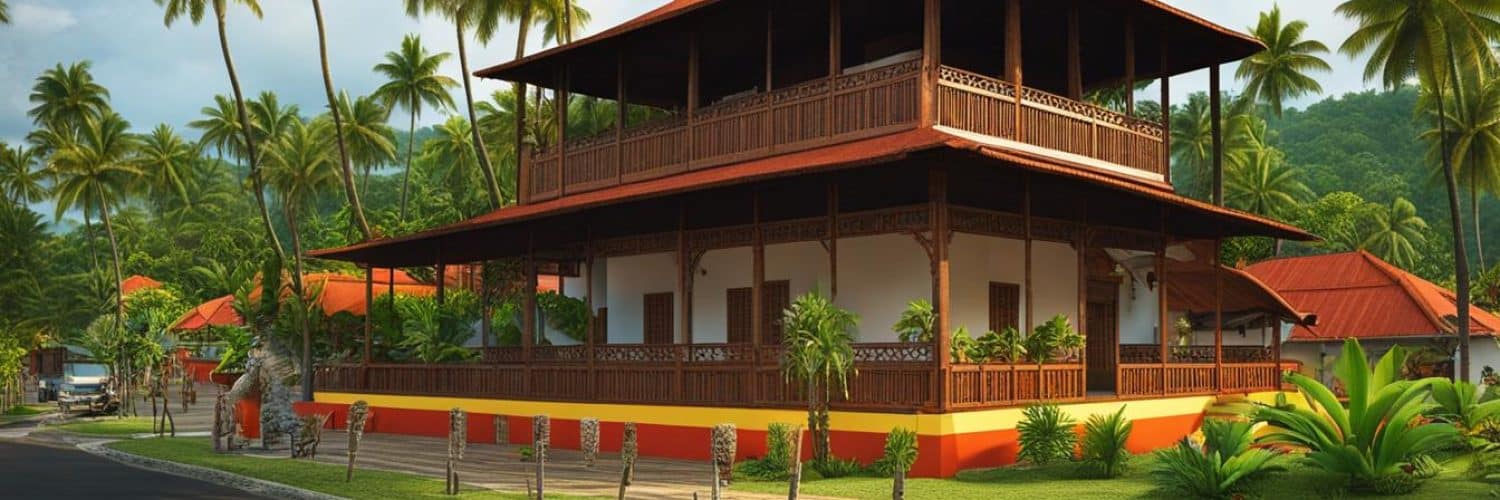Experience the vibrant cultural heritage and local history of Samar, Philippines by visiting the Gandara Cultural Museum. This captivating museum offers a fascinating museum tour that allows visitors to explore the rich tapestry of Gandara’s past.
Immerse yourself in the treasures of Gandara as you delve into the historical artifacts, indigenous crafts, and vibrant folk traditions showcased at the museum. Gain a deeper understanding of the cultural roots that have shaped Samar and discover the creativity and craftsmanship of the local community.
Located in Gandara, Samar, the museum is easily accessible to both locals and tourists, making it a must-visit destination for anyone seeking a meaningful and educational experience. Whether you’re interested in local history, art exhibitions, or participating in educational programs, the Gandara Cultural Museum has something for everyone.
Key Takeaways:
- Explore the rich cultural heritage and local history of Gandara, Samar at the Gandara Cultural Museum.
- Take a museum tour to discover historical artifacts, indigenous crafts, and vibrant folk traditions.
- Engage with art exhibitions and participate in educational programs that offer a hands-on learning experience.
- Plan your visit to the Gandara Cultural Museum, considering the museum’s operating hours and any specific guidelines or requirements.
- While in Gandara, explore nearby attractions and indulge in the local cuisine to complete the cultural experience.
Explore Gandara’s Rich History
The Gandara Cultural Museum is a treasure trove of historical artifacts, immersing visitors in the rich history of Gandara. Through a curated collection of ancient relics and colonial-era artifacts, the museum tells the captivating story of this town and its significant role in the region.
Step into the past as you admire the intricate details of archaeological finds and discover the remnants of Gandara’s vibrant history. From pottery and tools to pottery and tools, each artifact unveils a unique chapter in the town’s cultural heritage.
“The Gandara Cultural Museum provides a window into the town’s glorious past. Through its collection of historical artifacts, visitors can witness Gandara’s journey through time and gain a deeper understanding of its cultural significance.” – Local Historian
The exhibits at the Gandara Cultural Museum not only showcase the artifacts but also provide valuable insights into the town’s influential role in shaping the history of Samar. Delve into tales of trade, colonization, and local traditions as you explore the museum’s well-curated displays.
This immersive experience allows visitors to appreciate the town’s heritage and the resilience of its people throughout the centuries. It serves as a reminder of the importance of preserving and celebrating local history.
Highlights of Gandara’s Historical Artifacts
| Artifact | Time Period |
|---|---|
| Ancient Pottery | Pre-colonial era |
| Colonial-era Furnishings | Spanish colonization |
| Traditional Textiles | Indigenous heritage |
| Historical Documents | American period |
Visiting the Gandara Cultural Museum is an opportunity to connect with the past and gain a deeper appreciation for the town’s cultural heritage. The artifacts on display offer a tangible link to the history of Gandara and its enduring legacy in Samar.
Immerse Yourself in Indigenous Crafts
One of the highlights of the Gandara Cultural Museum is its focus on indigenous crafts. Visitors have the unique opportunity to witness the intricate craftsmanship of local artisans and explore the traditional techniques passed down through generations. From weaving to pottery, the museum showcases a diverse range of indigenous crafts that have played a significant role in shaping Gandara’s cultural heritage.
Indigenous crafts offer a glimpse into the region’s rich history and are a testament to the creativity and skill of the local community. Whether it’s marveling at beautifully woven textiles or admiring meticulously crafted pottery, visitors are sure to be captivated by the exceptional artistry on display.
Exploring Indigenous Crafts
The Gandara Cultural Museum presents a wide array of indigenous crafts, each with its own unique story and cultural significance. Here are just a few examples:
“The intricate weaving patterns displayed at the museum showcase the mastery of local weavers. From vibrant traditional clothing to intricate mats and baskets, the weaving traditions of Gandara are deeply intertwined with the cultural identity of the region.”
“The pottery collection offers a glimpse into the region’s ancient ceramics tradition. Visitors can admire stunning pieces, each meticulously handcrafted and adorned with indigenous motifs, reflecting the deep connection between art and nature.”
By immersing themselves in the world of indigenous crafts, visitors can gain a deeper appreciation for Gandara’s cultural heritage and the significance of these artistic traditions.
| Craft | Description |
|---|---|
| Weaving | Traditional textiles, mats, and baskets woven using intricate patterns and techniques. |
| Pottery | Handcrafted ceramics adorned with indigenous motifs, reflecting a deep connection to nature. |
| Bamboo Crafts | Artistic and functional items made from bamboo, showcasing the resourcefulness of local craftsmen. |
| Jewelry Making | Exquisite jewelry pieces crafted using indigenous materials like shells, seeds, and precious stones. |
The Gandara Cultural Museum’s collection of indigenous crafts is a testament to the rich artistic heritage of the region. It offers visitors a chance to explore the diverse traditions that have shaped Gandara’s cultural identity, providing insights into the craftsmanship and creativity of the local community.
Experience Vibrant Folk Traditions
Folk traditions are an integral part of Gandara’s cultural heritage, and the Gandara Cultural Museum celebrates these vibrant traditions. Visitors to the museum can immerse themselves in the rich tapestry of folk traditions through engaging performances of traditional dances, music, and storytelling. These art forms have been lovingly preserved and passed down through generations, serving as a testament to the customs and beliefs of the local community.
At the heart of the museum’s dedication to preserving folk traditions is the belief that they are a vital link to the past and embody the essence of Gandara’s cultural identity. Through these performances, visitors can witness the beauty and intricacy of traditional dances, accompanied by the rhythmic beats of indigenous music. Additionally, storytelling sessions allow visitors to delve into the captivating narratives that have been passed down orally from one generation to the next.
One of the museum’s highlights is the Gandara Folk Ensemble, a group of skilled performers who bring these traditional art forms to life. The ensemble showcases their talents at regular intervals, treating visitors to a captivating display of color, movement, and sound. Witnessing these performances is an unforgettable experience that not only entertains but also deepens one’s appreciation for the cultural heritage of Gandara.
The museum’s commitment to preserving and promoting folk traditions extends beyond performances. It also houses exhibits that provide further insight into the customs and rituals associated with these traditions. Visitors can explore displays of traditional costumes, musical instruments, and visual artworks that depict scenes from folklore and mythology.
“Folk traditions are like windows to the past, allowing us to glimpse the lives and values of our ancestors. They are the threads that connect us to our cultural roots, and it is our duty to ensure their preservation and promotion.” – Museum Curator
Celebrating Diversity
One remarkable aspect of folk traditions in Gandara is their diversity. The region’s cultural heritage is rich with unique customs and practices that vary from one community to another. The museum diligently honors this diversity by featuring performances and exhibits that highlight the distinct folk traditions of different ethnic groups and villages within Gandara.
The Gandara Cultural Museum serves as a platform for cultural exchange and appreciation, inviting visitors to embrace and celebrate the diverse tapestry of folk traditions within the region.
| Folk Tradition | Origin | Distinct Features |
|---|---|---|
| Tinikling | Visayan Origin | A dance performed with bamboo poles, involving intricate footwork and coordination |
| Singkil | Maranao Origin | A dance inspired by the epic tale of the “Darangen,” characterized by graceful movements and the placement of fans |
| Pangalay | Tausug Origin | A dance form that showcases fluid and graceful movements, often accompanied by the melodic sounds of the kulintang ensemble |
These are just a few examples of the diverse folk traditions celebrated at the Gandara Cultural Museum. Each tradition carries its own unique story, symbolism, and cultural significance, making them essential elements of Gandara’s cultural heritage.
Engage with Art Exhibitions
The Gandara Cultural Museum is not only a repository of historical artifacts and indigenous crafts but also a vibrant hub for art exhibitions that celebrate the intersection of art and culture in Gandara. These exhibitions serve as a platform for local and regional artists to showcase their talent, express their creativity, and explore themes deeply intertwined with Gandara’s cultural heritage.
Visitors to the museum have the opportunity to appreciate a diverse range of artistic styles and mediums, from traditional to contemporary. The art exhibitions offer a visually captivating experience, allowing visitors to immerse themselves in the vibrant world of Gandara’s artistic expression.
Whether it’s a collection of paintings, sculptures, or mixed-media installations, each exhibition at the Gandara Cultural Museum tells a unique story, reflecting the rich history, traditions, and customs of Gandara. Through art, visitors gain a deeper understanding and appreciation for the cultural tapestry that defines the town.
| Benefits of Engaging with Art Exhibitions at Gandara Cultural Museum |
|
|---|
Engaging with art exhibitions at the Gandara Cultural Museum is an enriching experience that invites visitors to delve into the depths of cultural expression and creativity. By participating in these exhibitions, visitors contribute to the preservation and promotion of art as an integral part of Gandara’s cultural heritage.
Participate in Educational Programs
The Gandara Cultural Museum offers a variety of educational programs designed to cater to visitors of all ages. These programs provide an interactive and engaging learning experience, allowing participants to delve deeper into Gandara’s cultural heritage. Whether you’re interested in traditional crafts or the rich history of the region, these educational programs offer a unique opportunity to engage with the exhibits and enhance your understanding.
Guided Tours
Embark on a guided tour of the Gandara Cultural Museum and gain valuable insights from knowledgeable guides. Learn about the significance of the historical artifacts, indigenous crafts, and folk traditions displayed in the museum. The guided tours are informative, offering a wealth of information that brings the exhibits to life.
Workshops and Demonstrations
Participate in workshops and demonstrations organized by the museum to learn firsthand about traditional crafts and techniques. From weaving and pottery to traditional music and dance, these workshops allow visitors to actively engage in the cultural practices of Gandara. Discover the intricacies of these art forms and gain hands-on experience under the guidance of skilled artisans.
Interactive Activities
The museum offers interactive activities that cater specifically to younger visitors, making learning about cultural heritage a fun and enriching experience. These activities may include art projects, games, and storytelling sessions that aim to spark curiosity and foster a deeper appreciation for Gandara’s traditions and history.
By participating in these educational programs, visitors can broaden their knowledge and understanding of Gandara’s cultural heritage. Whether you’re a history enthusiast, an art lover, or simply curious about local traditions, the museum’s educational programs offer a unique and immersive way to connect with the rich cultural tapestry of the region.
Location and Accessibility
The Gandara Cultural Museum is conveniently located in Gandara, Samar, making it easily accessible for both locals and tourists. Situated in the heart of Gandara, the museum is a treasure trove of cultural heritage and history.
Visitors to the museum have several options for getting to Gandara, depending on their starting point. For those traveling from Manila, the closest airport is Calbayog City. From Manila, visitors can take a direct flight to Calbayog City, which offers a convenient and efficient way to reach Gandara.
Once in Calbayog City, it is just a short travel to Gandara, where the museum is located. Visitors can take a taxi or arrange for transportation to the museum. The journey from Calbayog City to Gandara is relatively quick, allowing visitors to start their cultural exploration in no time.
If traveling from other parts of the Philippines, another option is to fly or take a bus to Tacloban City. Tacloban City is also within a reasonable distance to Gandara, making it a viable gateway for tourists. From Tacloban City, visitors can then take a bus or arrange for transportation to Gandara.
- From Manila: Fly to Calbayog City, then travel to Gandara.
- From other parts of the Philippines: Fly or take a bus to Tacloban City, then travel to Gandara.
Whether by air or land, reaching the Gandara Cultural Museum is a convenient and straightforward journey. Once there, visitors can immerse themselves in the rich cultural heritage and history of Gandara and Samar.
Visitor Testimonial:
“The Gandara Cultural Museum is truly a hidden gem in Samar. Its location in Gandara makes it easily accessible, and the journey to get there is part of the adventure. The museum is well worth a visit for anyone interested in learning about the cultural heritage of the region. I highly recommend making the trip!”
– Sarah, History Enthusiast
Plan Your Visit
When planning a visit to the Gandara Cultural Museum, it’s important to gather all the necessary information to make your experience enjoyable and hassle-free. Here are some essential details to consider:
Operating Hours
Before heading to the museum, check the operating hours to ensure that it is open to the public. The museum may have specific hours of operation on certain days or during holidays, so it’s always best to verify beforehand. This will help you plan your visit accordingly and avoid any disappointment.
Guidelines and Requirements
Be sure to familiarize yourself with any guidelines or requirements set by the Gandara Cultural Museum. This may include dress codes, photography restrictions, or rules regarding the handling of artifacts. Respecting these guidelines will contribute to a respectful and enjoyable visit for everyone.
Entrance Fees
While some exhibits or events at the museum may offer free admission, it’s important to check if there are any entrance fees for certain exhibitions or for access to the entire museum. Being aware of the fees will help you plan your budget accordingly and avoid any surprises.
Guided Tours and Audio Guides
To enhance your museum experience and gain deeper insights into the exhibits, consider inquiring about guided tours or audio guides. These resources can provide valuable information about the artifacts, local history, and cultural significance of Gandara. Engaging with knowledgeable guides or audio guides will enrich your visit and ensure a more immersive experience.
Respectful Visit
As you explore the Gandara Cultural Museum, remember to be respectful of the artifacts, exhibits, and other visitors. Follow the museum’s rules and regulations, avoid touching or tampering with the displays, and keep noise to a minimum to create a peaceful environment for everyone to enjoy.
By planning your visit to the Gandara Cultural Museum comprehensively, you can maximize your experience and gain a deeper appreciation for the cultural heritage of Gandara, Samar Philippines.
Nearby Attractions and Activities
While visiting the Gandara Cultural Museum in Samar, Philippines, there are other attractions and activities in the surrounding area that visitors can explore. These additional experiences further enhance the cultural immersion and offer a well-rounded itinerary when exploring Gandara.
The Karabaw Festival is one such attraction that shouldn’t be missed. This vibrant celebration showcases the local culture and traditions of Samar. Visitors can witness colorful parades, traditional dances, and music performances, immersing themselves in the lively atmosphere of the festival.
Another must-visit attraction near the museum is The Quarry, a stunning natural attraction known for its crystal clear water and picturesque views. Visitors can enjoy swimming, picnicking, or simply admiring the beauty of the surrounding landscape. The Quarry offers a peaceful escape and allows visitors to connect with nature.
Exploring these nearby attractions adds a unique dimension to the overall experience of visiting Gandara and its cultural offerings. Whether attending local festivals or appreciating the natural beauty of the region, there is something for everyone to enjoy.
| Attraction | Description |
|---|---|
| Karabaw Festival | A vibrant celebration of the local culture and traditions, showcasing parades, traditional dances, and music performances |
| The Quarry | A natural attraction known for its clean water and stunning views, offering opportunities for swimming, picnicking, and relaxation |
Sample Local Cuisine
To complete the cultural experience in Gandara, you must indulge in the local cuisine. The area is home to a range of restaurants and food stalls where you can savor traditional dishes made with fresh local ingredients. From sumptuous seafood delicacies to hearty stews cooked with love, the local cuisine reflects the flavors and culinary heritage of Samar.
If you’re a seafood lover, be sure to try the mouthwatering shrimp sinigang or the grilled squid with garlic butter sauce. These dishes highlight the region’s bountiful coastal resources and the skill of the local chefs. For those with a taste for meat, the hearty beef kare-kare or the flavorful chicken adobo should not be missed. These dishes are prepared using traditional recipes passed down through generations, capturing the essence of Samar’s cuisine.
Signature Dishes of Gandara
In addition to the staples, Gandara boasts some unique signature dishes that you won’t find elsewhere. One such dish is binakol, a comforting chicken soup made with native coconut juice and various herbs and spices. The combination of the tender chicken and the rich broth creates a harmonious blend of flavors that is sure to tantalize your taste buds.
Another local delicacy worth trying is the Sampaloc candy, a sweet and tangy treat made from tamarind pulp, sugar, and other natural ingredients. This chewy candy is a favorite among locals and visitors alike, providing a delightful burst of flavor in every bite.
“The flavors of Gandara’s local cuisine are a testament to the region’s rich cultural heritage and gastronomic traditions. Each dish tells a story, connecting us to the people and the land that have shaped Samar’s culinary landscape.”
No cultural experience is complete without exploring the local cuisine, and a visit to Gandara is no exception. Indulge in the diverse flavors and culinary wonders of Samar’s cuisine, and let your taste buds be your guide as you immerse yourself in the cultural tapestry of this enchanting destination.
Conclusion
The Gandara Cultural Museum in Samar, Philippines, is a treasure trove of cultural heritage and local history. It offers visitors a fascinating glimpse into the rich traditions and customs of Gandara, allowing them to explore the region’s indigenous crafts, vibrant folk traditions, and captivating art exhibitions. The museum’s educational programs provide an immersive experience that deepens the understanding of Gandara’s cultural heritage.
Conveniently located in Gandara, Samar, the museum is easily accessible for both locals and tourists. Whether you are a history enthusiast, an art lover, or simply curious about the local way of life, a visit to the Gandara Cultural Museum is a must. It is an opportunity to learn about the distinct cultural fabric of Samar, appreciate the intricacies of indigenous craftsmanship, and witness the vibrant folk traditions that have been passed down through generations.
Plan your visit and check the museum’s operating hours, as well as any specific guidelines for visitors. Consider taking a guided tour or using audio guides to enhance your museum experience. Admission fees may apply, but some exhibits or events may offer free admission. It is important to respect the museum’s rules and regulations to ensure an enjoyable visit that honors Gandara’s cultural heritage.
Immerse yourself in the fascinating history and cultural wonders of Gandara at the Gandara Cultural Museum. It is a journey that will broaden your horizons and leave you with a deeper appreciation for the rich tapestry of Samar’s cultural heritage.
FAQ
What is the Gandara Cultural Museum?
The Gandara Cultural Museum is a destination in Samar, Philippines that showcases the rich cultural heritage and local history of Gandara.
What can visitors explore at the Gandara Cultural Museum?
Visitors can explore historical artifacts, indigenous crafts, vibrant folk traditions, and art exhibitions at the Gandara Cultural Museum.
What does the Gandara Cultural Museum offer in terms of historical artifacts?
The museum provides a comprehensive collection of historical artifacts that tell the story of Gandara’s rich history, including ancient relics and colonial-era artifacts.
What can visitors experience regarding indigenous crafts at the Gandara Cultural Museum?
Visitors can witness the intricate craftsmanship of local artisans and learn about traditional techniques passed down through generations, such as weaving and pottery.
How does the Gandara Cultural Museum celebrate folk traditions?
The museum showcases performances of traditional dances, music, and storytelling that have been preserved and passed down through generations, allowing visitors to engage with these vibrant folk traditions.
What kind of art exhibitions does the Gandara Cultural Museum host?
The museum frequently hosts art exhibitions that showcase the works of local and regional artists, promoting the arts and exploring themes related to Gandara’s cultural heritage.
Can visitors participate in educational programs at the Gandara Cultural Museum?
Yes, the museum offers educational programs for visitors of all ages, including guided tours, workshops, and interactive activities that provide a hands-on learning experience.
How can visitors reach the Gandara Cultural Museum?
What should visitors consider when planning a visit to the Gandara Cultural Museum?
What other attractions and activities are there to explore near the Gandara Cultural Museum?
Visitors can explore attractions such as the Karabaw Festival, a celebration of local culture and traditions, or visit the Quarry, a natural attraction known for its clean water and stunning views.
What should visitors do to complete the cultural experience in Gandara?
Visitors should sample the local cuisine, which offers traditional dishes made with local ingredients and reflects the flavors and culinary heritage of Samar.


















Add comment